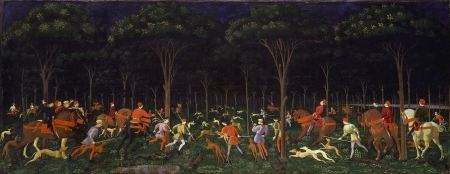(course for Artscience 2007/8)
taught together with Michael van Hoogenhuyze

A continuing thread through the history of visual art is the idea that the artist communicates or explores a way of seeing through his or her work. In this way a work of art is not so much a representation of an object or an event, but rather an example or demonstration of how the world can be looked at.
An important part of the structure of this ‘demonstrated’ perception is the way space is organized. Around the fifteenth century perspective was invented in western painting, and since then this way of depicting space has become the norm to which all other visual representations of space are compared. The photocamera, the filmcamera and their modern variants have been designed to produce images according to this perspective originally invented by painters. Graphics cards of computers have the laws of perspective hardwired in their chips. Virtual reality is both state of the art and the ultimate embodiment of principles that were already written down for the first time in 1435.
With perspective in the Renaissance emerge also the artist as an individual and the concept of freedom for human beings. The illusionary space of perspective made it possible to show humans in potential situations, to show possible worlds; things that were not shown in art before the invention of perspective: up to then artists showed accepted doctrines and stories. Perspective was accepted as a ‘scientific’ and true method based on optics, but also as a model of how people could observe space, and gradually people realised that perpective was mostly about a way of looking at reality.
Towards the end of the nineteenth century the concept of space changed. Scientists, artists and spiritual thinkers were highly interested in the concept of the fourth dimension, the non-euclidean geometry based on curved lines and other kinds of space that were invented in that period. One came to realize that there is a connection between space and observation and between space and movement. One of the results of this was the development of the concept of space-time by Laszlo Moholy-Nagy and Siegfried Giedion. Space was no longer a static concept, but was to be seen as a field to be navigated through. Cubist space or film space do no longer offer a vista from a privileged point of view, but offer an orchestrated sequence of sensations.
Towards the end of the twentieth century a completely new space emerged: Cyberspace. This space appears to be real and at the same time not geometric or not real in any physically determined way. We use completely new concepts to visualise or understand this space: rhizomes, networks consisting of nodes without any hierarchy, etc.
In the research group we will go back to the principles of perspective and try to develop our own representations of space. We will use the augmented reality-facilities of the AR+RFID lab, as well as more traditional projection equipment. As a point of departure for our investigations we will study and realize several historical examples from painting, experimental film, video art and virtual reality. The main question we will be asking is whether these existing spatial models have any connection with our inner mental space ? How can media artists ‘demonstrate’ their personal perceptions and spatial intuitions when their tools all have the same concepts of space embedded in them ? Can we make a model of our inner space when we learn about many other models of space ? At the end of this research group everybody shows a model of his or her own mental space.
